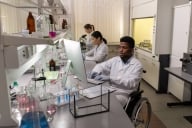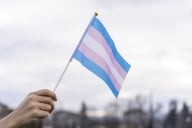You have /5 articles left.
Sign up for a free account or log in.
My name is Deborah Saint-Phard. I am a Black woman physician who works in a medical academic department and who founded and directs a women’s sports medicine program. And I live at the intersection of physician burnout, the COVID-19 pandemic and systemic racism.
In 2016, during my annual review with my chairperson, I stated point-blank, “I cannot think about stress fractures anymore.” Since this had been my clinical area of expertise for more than two decades, that pronouncement was a bit surprising to us both. Instead, I wanted to work on emotional stress fractures, also known as burnout.
My exploration led me to discover the epidemic of physician suicide in America. Was this a well-kept secret: 400 physicians in America die each year by suicide? Could it be true that the equivalent of two and a half medical school classes per year die by suicide? I wanted to call out to my former medical school peers and current doctors everywhere to make sure they knew suicide is an occupational hazard in medicine. Female physicians have 2.3 times, and male physicians 1.4 times, the risk of dying by suicide when compared to the general population.
In May 2018, I convened a two-day conference in the Colorado mountains for physicians, physicians’ assistants, nurses, CEOs and hospital administrators to learn about this urgent concern. I read articles and presented grand rounds locally and keynotes regionally on this topic; attended local, regional and national conferences on physician health; joined committees on physician resilience; and worked to implement this topic into our medical school curriculum. My goal was to increase awareness about the new World Health Organization’s International Classification of Disease (ICD) code 11, which is a specific medical diagnosis category for physician burnout, and develop strategies for self-care and self-compassion. The ICD code 11 defines physician burnout as an occupational syndrome -- not a medical phenomenon -- caused by chronic workplace stress resulting in: “a) Feelings of energy depletion or exhaustion, b) increased mental distance from one’s job, or feelings of negativism or cynicism related to one’s job and c) reduced professional efficacy.”
By 2019, I felt that my efforts were meaningful. I had increased awareness of the insidious emotional toll a physician’s work can have on them.
Then in early 2020, the infectious airborne pandemic COVID-19 struck us in the United States. Warnings blared about the insufficient amounts of personal protective equipment, or PPE, to keep health-care workers safe while providing care to infected patients. The rationed PPE, falsehoods and misinformation about the seriousness of this pandemic from leaders responsible for public policy, and lack of a national mandate for social distancing and wearing masks or face coverings undermined my feeling of physical safety. While debates flared about rights of individual choice versus public health directives to prevent community spread of this virus, I felt my vulnerability more and more acutely. If I became infected with COVID-19, my co-morbidities -- Black person, underlying respiratory condition, hypertension and overweight -- would predict a poorer outcome.
As COVID-19 cases accelerated, our ambulatory clinics were closed, and we were furloughed. I was reassigned to help staff an employee-health COVID command center for several weeks to assist with the overwhelming number of calls, tests and dispositions. We were encouraged to use this downtime to be productive academically. We transitioned to providing care via telehealth from home. I saw and felt the emotional toll of the pandemic on physicians, compounding burnout, and read the research showing how providing care during pandemics leaves health-care workers at increased risk for depression, anxiety, substance use and PTSD.
And then I learned about Breonna Taylor’s death in March. She was killed by multiple gunshots from police while she slept in her own bed. And then I watched George Floyd’s death on television in May -- his neck unmercifully kneeled upon by a police officer for eight minutes and 46 seconds.
Those two events struck at the soul of the nation and broke my heart. They alarmed me to the core: I saw that I could not secure the physical safety of my Black body or those of my Black children. America’s 400-year history of using Black bodies for capitalistic gains and its unrelenting racism continues to threaten my existence because my skin color. My security system will not protect me. My locked doors will not protect me. My medical degree will not protect me. My Princeton University undergraduate degree will not protect me. My Olympic medal will not protect me. My fancy car will not protect me.
Because I am Black in America, I am seen as less than human and am subject to being treated as an animal, just like Breonna Taylor and George Floyd were, along with many others.
Fighting the Epidemic of Systemic Racism
My physician parents immigrated to the United States from Haiti when my brother was a toddler and I was a baby. They worked in Baltimore and New York hospitals until they secured residency positions at Menninger’s School of Psychiatry in Topeka, Kan. They raised us speaking French at home and instilled in us the virtues of God, family and education as our beacons to follow as we grew up. I believed I had agency in America to pursue life, liberty and happiness. But this idealism has faltered as I acknowledge the immense strain of living at the intersection of an epidemic of racism, the COVID-19 pandemic and a surge of physician burnout.
In 2020, Joe Biden was declared the 46th president-elect to lead this nation. Biden chose Senator Kamala Harris to be the first Black woman ever to serve as vice president of the United States of America. Watching this happen gives me hope. It gives me hope that I will find my voice to stand with Black, Indigenous and people of color (BIPOC) to change our institutions. Now my inspiration is for BIPOC to feel comfortable as our patients and in our hospitals, medical schools and graduate level training centers. The intersection of physician burnout and suicides, the COVID-19 infectious pandemic, and the epidemic of systemic racism in America increases the urgency of making our institutions actively antiracist.
Ibram X. Kendi, author of How to Be an Antiracist, defines a racist as one who is supporting a racist policy through their actions or inaction or by expressing a racist idea. He defines an antiracist as one who is expressing the idea that racial groups are equal and is supporting policy that reduces racial inequity. Kendi says, “It is the system, not a racial group, that needs to be changed. And then we spend our time, we spend our funds, we spend our energy challenging racist policy and power.” We must educate ourselves and then take action right where we are. Systemic racism undermines all diversity and inclusion goals that our institutions may have.
Please do the following in order to create a more equitable America: work to be antiracist. This will bring equity to differing racial groups. Each of us leading our institutions to become antiracist will be the beginning of actual change and healing for each of us and our nation. Read and execute The Business Case for Investing in Physician Well-being by Tait Shanafelt, Joel Goh and Christine Sinsky. Tell everyone everywhere to wear masks, wash their hands regularly, practice social distancing to stop community spread of COVID-19 and get the vaccine once it is available. Read and implement The Mindful Self-Compassion Workbook by Kristin Neff. If we all do these things, we have a chance to heal these emotional stress fractures while mitigating the medical profession’s most dangerous occupational hazard: suicide.




